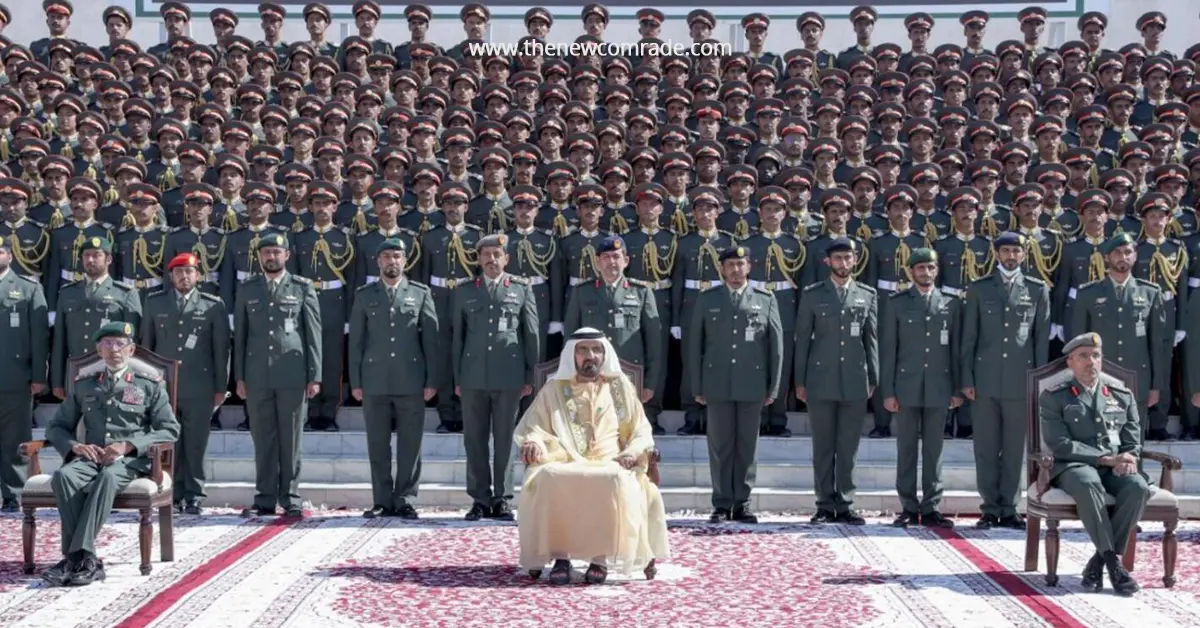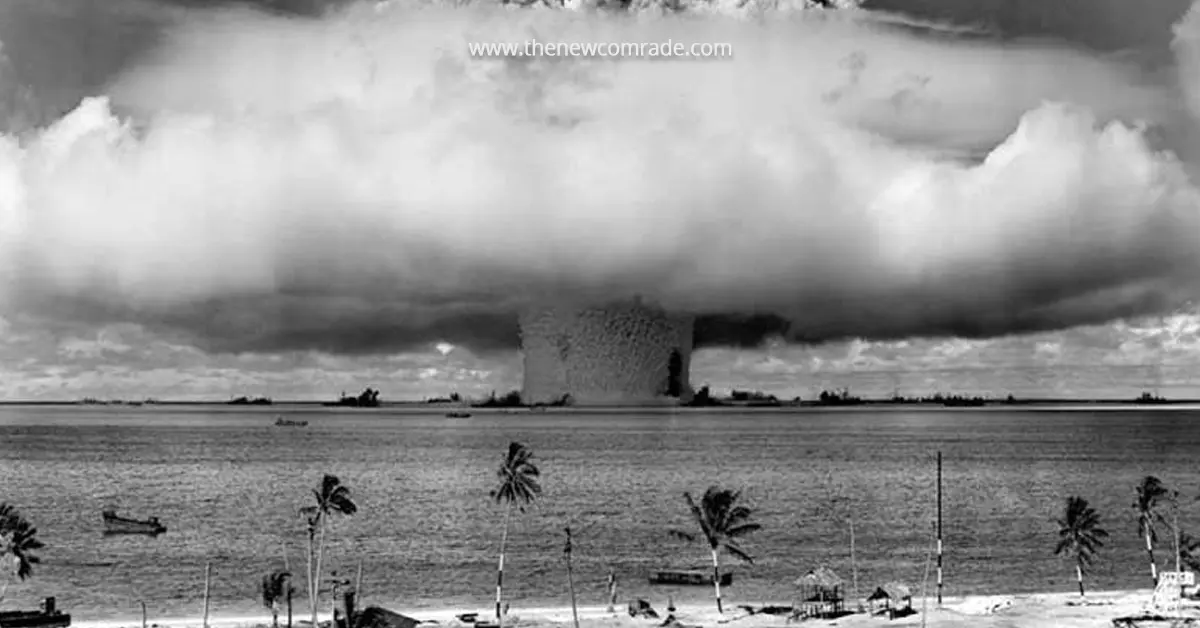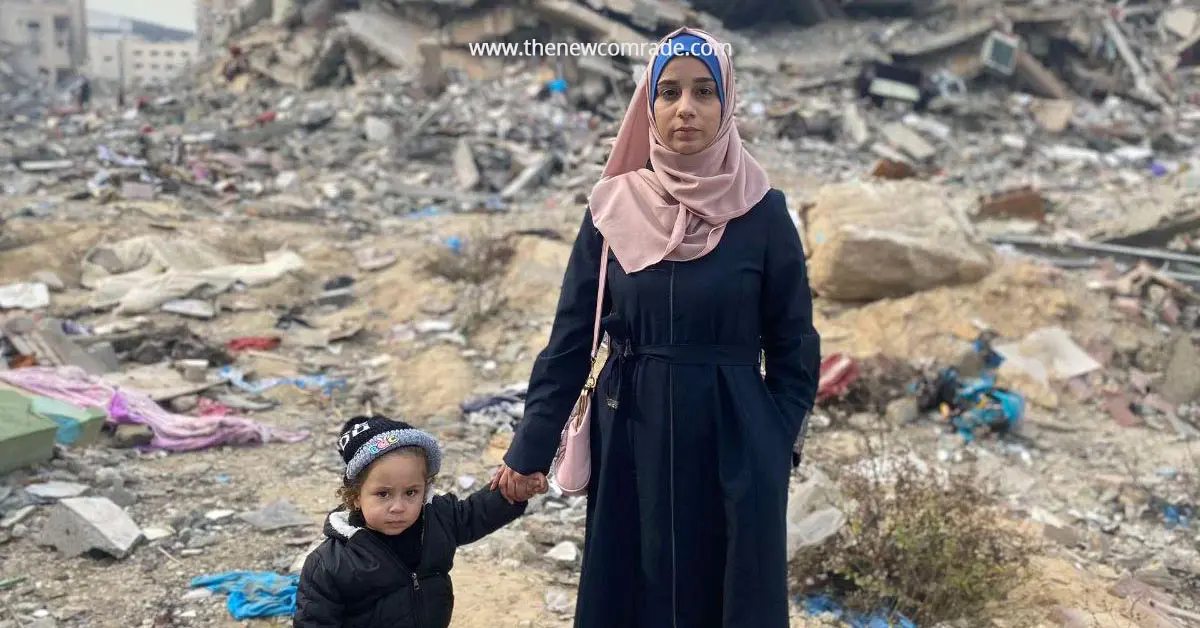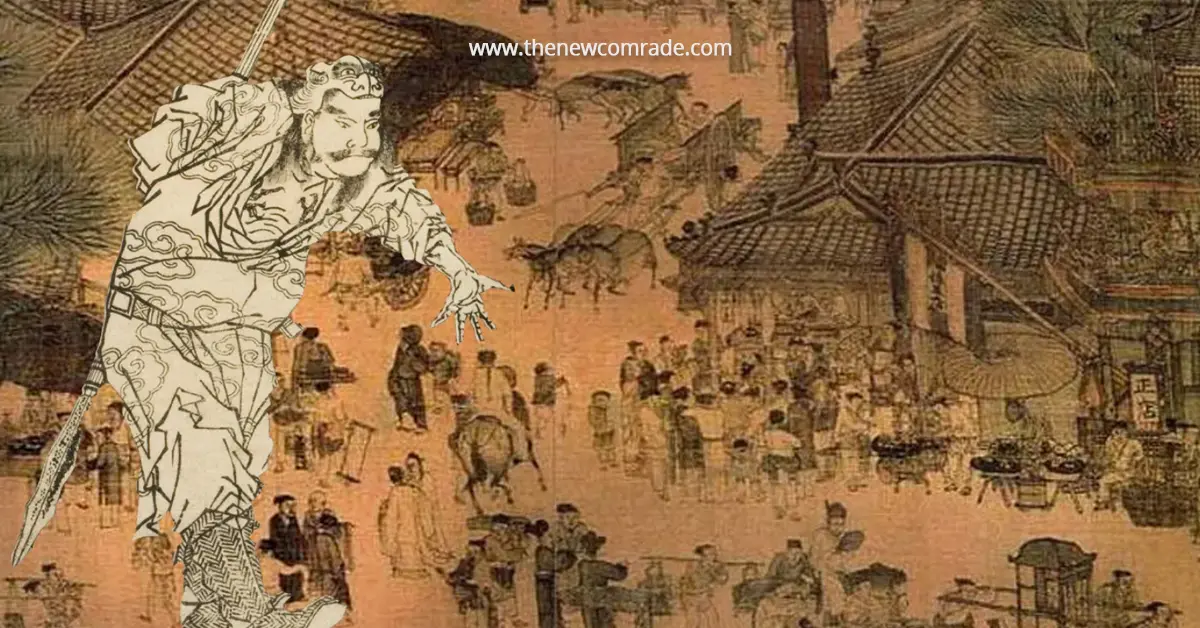1. Establishment of Presidential Guard
Crown prince of Abu Dhabi and deputy supreme commander of armed forces, Mohammed Bin Zayed, issued a directive in February 2011 to establish a presidential guard. It is a strike force that includes land, air, and sea forces. An “anti-terror” task force called Special Operations Command also works within guard’s ranks. In June 2012, an institute constituting of two schools was added to the presidential guard: One for basic military training and the other for advanced training to give soldiers specialised training according to their assignment within the presidential guard units.

Presidential guard’s soldiers are trained according to US Marine Corps curricula. This was implemented by first sending a delegation of presidential guard officers to the training centres of the First Marine Corps Division in the United States in March 2011, in coordination with the US Central Command (CentCom). By end of 2012, a group of 30 US Marine trainers were dispatched to supervise training of presidential guards. Australian major general Michael Simon Hindmarsh, who previously served as Commander of Joint Command for Special Operations in WANA for Australian Army, was entrusted with presidential guard’s command. Hindmarsh’s assumption of this position is consistent with the Emirati military tradition of relying on foreign military advisers to establish new military branches and institutions, at least until Emiratis are experienced to take over these senior roles.
According to the IISS’s 2018 Military Balance Report, the presidential guard has approximately 50 Leclerc combat tanks, 290 armoured infantry vehicles, and anti-tank Cornet missiles. The guard structure consists of:
● One reconnaissance squadron
● One amphibious battalion
● A mechanised infantry brigade comprising of a tank battalion, four mechanised infantry battalions, an anti-tank company, a combat engineering company, and a combat support battalion.
2. Establishment of National Defence College
As the Emirati regime worked to develop its military and civilian cadres, a federal decree was issued in August 2012 establishing National Defence College in affiliation with the general command of the armed forces. The National Defence College was launched to be “a world-leading college in developing strategic thinking, a key source of strategic and security studies”. The college was officially inaugurated in December 2013. The college aims, according to its website, “to prepare and qualify both military and civilian leaders and hone their skills in identifying and assessing challenges to national, regional, and international security, as well as understanding the fundamentals and requirements for managing and employing state resources to defend national interests.”

Its first batch numbered 30 students. In view of the scarcity of Emirati experts in strategic affairs, the college relied, for its teaching faculty and administrative staff, on its partnership with the US National Defence University. Dean’s position was first assumed by John Randall Ballard, a former US Marine Corps officer. He continued in office until 2017, when he was replaced by Thomas Drohan, former head of Department of Military and Strategic Studies at United States Air Force (USAF) Academy.
Establishing the National Defence College reflected the desire of the Emirati regime to prepare local military and civilian elites to assume national security responsibilities, although prevailing political atmosphere within the UAE is one that does not lend itself to free discussions regarding actual strategic threats, priorities, and how to confront them from the perspective of what is in public interests. Rather, ruling regime’s security, forcible complicity with the ruling elite’s policies and orientations, occupy top priorities. This contradicts foundations of American defence curricula, from which UAE’s National Defence College borrows, since that curricula assume and depend on open and free public discussions. Contents of articles published by annual National Defence Journal, or by college graduates in the Shield of nation magazine, (Dir’ al Watan), of Armed Forces’ Directorate of Moral Guidance, also show that it takes a propagandistic approach that focuses on the leader’s wisdom, vision, generosity, and approval, not on discussing the UAE’s political strategies critically, professionally, or independently.
3. Compulsory Recruitment
Following emphasis on the role of various countries’ youth in the 2011 Arab Spring uprisings, the Emirati regime began to act pre-emptive about revolutionary fervour spreading across the region. Furthermore, UAE’s increased involvement in regional conflicts caused the regime to worry about its own security. Thus, in 2014, the regime enacted Article 43 of its constitution, which states: “… defence of the Union shall be a sacred duty obligatory upon every citizen. The aim of military service shall be an honour for citizens and shall be regulated by law”. Thus, compulsory recruitment was levied on males between ages of 18 and 30 for a period of two years for those with education is less than secondary school, and nine months for those qualified with secondary education and above. Additionally, this constitutional provision opened door for non-compulsory recruitment for females, where their required service period would be nine months.
This mandatory period was eventually extended, first, in 2016, to require both men and women to serve for a full year. Then, in 2018, period of recruitment for those with educational certification of secondary school and above was extended, second time, to 16 months, and extended to three years for those below that education level. Voluntary recruitment was also opened in March 2016 to men between 30 and 40 years of age. Moreover, since August 2015, volunteer service was extended to the sons and daughters of female Emirati citizens married to foreigners, tempting this group by promising to grant them citizenship if they volunteered for military service.
Institutions in which recruits serve include the armed forces, ministries of defence and interior, the state security apparatus, and any military entities and institutions. These steps took place in a festive atmosphere that included highlighting the conscription of rulers’ daughters, such as Ḥessa bint Mohammed bin Zayed and Fatima bint Abdullah bin Zayed. These steps aimed at inculcating an inclusive ‘national identity’, as well as assuring loyalty to ruling families within an approach of re-engineering Emirati society.
4.Appointing a ‘Minister of State’ for ‘Defence Affairs’
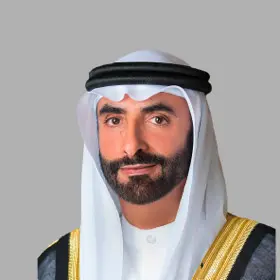
Mohammed bin Rashid Al-Maktoum had assumed position of minister of defence following establishment of the Union in 1971, when he was only 22 years old. With increasing involvement of UAE in military conflicts and difficulty of assuming and combining all of his positions as Prime Minister, Ruler of Dubai, and Minister of Defence, in February 2016, UAE government introduced the position of “Minister of State” for Defence Affairs. This position is currently held by Mohammed Al-Bawārdī, who holds a Bachelor’s degree in history and political science from Lewis and Clark College in the United States, and was working as under-secretary at the Ministry of Defence. It is also worth mentioning that army field commander is the chief of staff.
Genesis and Development of Military Education
There are many military colleges, most prominent of which are:
1. Zayed II Military College
Established in 1972, the first military college was founded in Abu Dhabi. For more than 10 years, the college was administered and supervised by five Jordanian army officers.
Internal college system was designed according to the famous British Sandhurst Academy’s system, and, since 1973, the college adopted the approach of sending some students annually to study in Sandhurst. By the end of 2012, number of Emiratis who received their studies at Sandhurst was 240, most notably, Mohammed bin Zayed, and the children of Mohammed bin Rāshid, viz. Ḥamdān, Mājid, and Mansur.
Number of the first batch graduated from Zayed II College was 73 officers. At the beginning of its establishment, the college faced obstacles, namely, that the UAE lacked qualified students due to the scarcity of educated people in general at the time. Jordanian army itself was established by British officers, and for decades Britain had overseen Jordan’s military affairs. Thus, the involvement of and reliance on Jordanian officers, as well as the scholarships to British military colleges, served to maintain Britain’s presence in UAE army.
2.Khalīfa bin Zayed Air College (KBZAC)
First air flight school was established at the Dhafra airbase in 1982. For its instruction, the school relied on a group of cadres that were trained to fly in foreign training programmes in Britain and US. In 1984, its name was changed to the Air College; then, in 1996, to Khalīfa bin Zayed Air College (KBZAC). This college’s students also expanded to include female graduates as well as students from outside UAE, where graduates at the end of 2018 included citizens of Lebanon, Jordan, Bahrain and Saudi Arabia.

3.Joint Command and Staff College (JCSC)
In September 1991, a federal decree was issued to establish Joint Command and Staff College (JCSC) to prepare officers selected for positions of command and staff in the armed forces. This college is specialised in teaching the art of war, especially with regard to that of military operations.
4. Naval College
Established in 1999. In 2013, it was renamed Rashid bin Saeed Al-Maktoum Naval College. The college draws on support from Pakistani naval forces to help shape its curricula, statute, and training programmes.
5. Khawla Bint al-Azwar School
First women’s military school in AGCC, Khawla Bint al-Azwar School was established in August 1990, just days after Iraq’s invasion of Kuwait. It aims to educate female officers, non-commissioned officers, and female soldiers who serve in the army.
Account and Formation of the UAE Armed Forces
Since its inception, the UAE Armed Forces have witnessed tremendous developments as their number increased from a few thousand men, mostly illiterate, in the early 1970s to 63,000 by 2019. The enumeration and distribution of the Emirati army’s manpower has evolved over the years.
According to Military Balance Report issued in 2019 by the London-based International Institute for Strategic Studies, (IISS), the UAE’s armed forces are currently composed of:
• 2 armoured brigades
• 2 mechanised infantry brigades
• 1 Infantry brigade
• 1 Artillery brigade
• 2 Air Defence Brigades and 3 Air Defence Missile Brigades
• 6 Squadrons of Fighter and Bomber aircraft
• 1 Squadron of Early Reconnaissance and Control and 2 Squadrons of Search and Rescue
• 3 Air Transport Squadrons
• 1 Helicopter Transport Squadron and 4 Training Squadrons
These formations do not include the Joint Air Force or Presidential Guard. As for armament, according to 2019 Military Balance Report, UAE military owns:
– 435 main battle tanks, 76 light tanks, 73 reconnaissance vehicles, 405 armoured infantry vehicles, 928 armoured personnel transport carriers, 53 armoured engineering vehicles, and 143 armoured repair vehicles, in addition to 600 assorted artillery pieces, 6 short-range Scud surface-to-surface missile batteries, and Patriot and THAD missile defence systems.
– 1 Warship, 10 frigates (Corvettes), 42 speed patrol boats equipped with missiles, 29 amphibious landing ships, 2 minesweepers, and 2 logistical support ships.
– An air force consisting of 156 advanced F-16 and Mirage 2000 fighter and bomber jets, as well as 21 attack helicopters, an undetermined number of Wing Long Unmanned Aerial Vehicle (UAVs), and other multipurpose aircrafts. The UAE also has 3 satellites for communications, imaging, and data transmission.
Developing Air and Naval Forces and Missile Defence Capabilities
Over the last decade in particular, the UAE has worked to develop its air force, naval force, and missile defence capabilities, especially with increasing Iranian missile capabilities, the emergence of the threat of transnational Muslim organisations, such as al-Qaeda and the Islamic State (ISIS), and its keenness to protect strategic maritime corridors in the Arabian Sea and the Indian Ocean. As for its air force, UAE acquired sophisticated early warning aircrafts, such as SAAB340, the C17 giant transport planes, Airbus Multi Role Tanker transport MRTT-330, air-to-air refuelling aircrafts, and advanced training plane PC-21.83 In 2018, US supplied the UAE with Mode5 system—a military air traffic surveillance system that US military and its allies use to identify each other’s airplanes and vehicles. It is the latest version of the IFF system, which is meant to distinguish foe from friend. Such technology is only shared with close US allies, such as NATO members and Israel.

As for the navy, in 2004, UAE contracted Abu Dhabi Ship Building Company to build six 62-metre-long corvette frigates. First one entered service in 2011, performing intercepting missions, surveillance work, and coast guard patrolling; it also contains a helipad, carries 20 anti-ship missiles, an air defence system, and electronic warfare equipment. In 2009, the UAE contracted the Abu Dhabi Ship Building Company to build twelve 27-metre-long missile ships of the type called “Granada”. In 2012, it contracted with the Italian Company Fincantieri to purchase three warships at a value of €300 million (Euros), so as to carry out maritime patrols, surveillance operations, and anti-submarine activities.
UAE was also keen on acquiring latest missile defence systems, such as THAAD. UAE contracted Lockheed Martin, producer of THAAD system, in December 2016, to provide them with two systems, whose value is estimated at US$5.3 billion; it was Lockheed Martin’s first contract outside US. UAE was also first West Asian state to acquire Patriot missile system (PAC-3), which is considered one of the most advanced defence missiles worldwide. On May 3, 2019, UAE obtained Pentagon’s approval to purchase 453 Patriot PAC-3 missiles at a cost of US$2.728 billion.
With UAE adopting a centralised military and network of information gathering, it has endeavoured to possess tools to help transfer information, data and images, draw maps, and link military units to each other through safer communication means. As a result, it launched three satellites in cooperation with European space and satellite companies. The first satellite was launched in 2011 from France and the second in 2012 from Kazakhstan. Finally, Khalīfa Sat satellite, which UAE claims is entirely manufactured by Emirati cadres, was launched from Japan in 2018. However, the fourth satellite, ‘Ayn al-Ṣaqr, or the falcon’s eye, which was intended for military and civilian purposes, was destroyed during its launch from the French Guiana base in July 2019.

